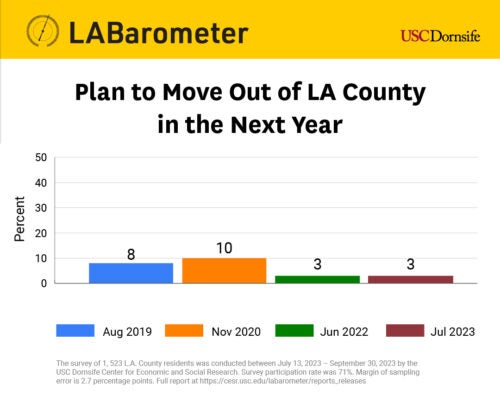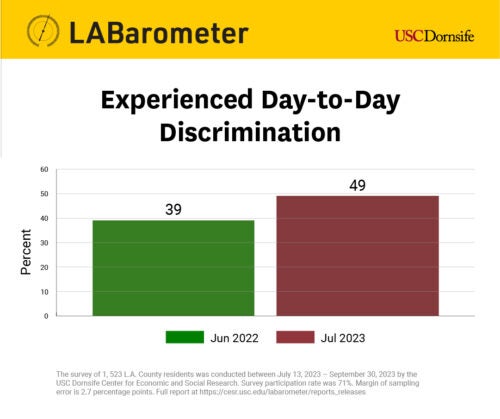
Pandemic-driven exodus from L.A. slows to a crawl, consumer confidence among Angelenos improves
Key Findings
Just 3% of Angelenos plan to leave L.A. County next year — a 70% decline from 2020. This reflects a national decrease in moving rates and may be associated with economic challenges associated with moving.
Consumer confidence regarding the local and national economy has risen significantly and fewer residents are reporting issues such as crime, loitering and vandalism in their neighborhoods.
Rents and mortgages in L.A. County have risen significantly. Nearly 20% of renters who moved in the last 12 months say they moved because their landlord raised their rent — up 6 percentage points from last year.
Reports of discrimination, particularly among Latinos and younger Angelenos, are on the rise.
While the rise of remote work and the pandemic’s outsized impact on the health and financial well-being of cities drove people out of urban areas and into cheaper, less densely populated regions, the 2023 USC Dornsife LABarometer survey finds that the pandemic-initiated exodus from Los Angeles County has come to a near standstill.
Just 3% of L.A. County residents plan to leave in the coming year, a dramatic 70% drop from 2020, when 10% said they planned to leave. That’s an “exodus rate” even lower than 2019, when 8% said they planned to leave the county. It’s a drop largely driven by renters, who are significantly less likely to leave than they were in 2020.
The researchers note that this change reflects a national decline in moving rates and may be associated with the economic challenges of moving. Still, the study finds Angelenos feel better about their neighborhoods and the economy.
Last year, 52% of residents reported issues such as crime, loitering, vandalism, and substance abuse in their neighborhoods, a figure that has since fallen to 47%. Additionally, there’s been a notable decrease in the number of Angelenos — by 5 percentage points since last year — who perceive an increase in the cost of goods and services locally. Meanwhile, consumer confidence in the economies of Los Angeles and the nation has been on an upward trend over the past two years, now approaching the levels seen before the pandemic.
“We see clear signs of recovery in L.A., as inflation cools, consumer confidence grows and neighborhood conditions improve,” said Kyla Thomas, director of LABarometer and associate sociologist at the USC Dornsife Center for Economic and Social Research. “In key respects, residents seem to view L.A. as a more livable place than they did just a year ago.”
Mortgage hikes and rising rents persist
Despite some rosier perceptions of life in L.A., housing challenges persist for many Angelenos. Nearly 20% who moved within L.A. during the previous 12 months say they did so because their rent increased, a 6-point jump from 2022. The study also finds median rent in Los Angeles hit a four-year high, climbing 12% from last year to $1,450. The rent hike was particularly large among moderate- to high-income renters, although low-income renters were the most likely to relocate due to increased rent.
“This uptick in rent-induced relocations paints a picture of a county still grappling with affordability and stability in its housing market,” said Thomas.
About 64% of L.A. renters now spend more than 30% of their income on rent, up from 61% in 2022 during the pandemic. Those who spend more than 30% of their income on rent are considered by the U.S. Department of Housing and Urban Development to be “rent-burdened.”
By contrast, only 20% of L.A. homeowners allocate more than 30% of their income to a mortgage — down from 22% in 2022, despite an 8% rise in the median mortgage.
“Homeownership is an increasingly selective and protective status in L.A. The bulk of housing insecurity is driven by renters, who are more vulnerable to market fluctuations,” said Thomas. “Allocating more than 30% of your income to rent increases your risk of displacement and limits your ability to afford essentials like food and medicine. Not to mention, rent burden is a chronic source of psychological stress, especially for low-income renters.”
Reports of discrimination on the rise
A disturbing finding from the study is the percentage of people reporting day-to-day discrimination, up nearly 10 points from last year to 49%, the highest since 2020. Latinos and people 18 to 39 experienced the largest increases in reports of discrimination. Among Latinos, this was driven by reports based on physical appearance. Among younger people, it was driven by an increase in discrimination based on job or religion.
Discrimination was defined as being treated generally with less courtesy or respect than others or receiving poorer service in restaurants or stores. In the most extreme cases, individuals said they were threatened or harassed, according to those surveyed.
About LABarometer
LABarometer is a research center housed at the USC Dornsife Center for Economic and Social Research (CESR). LABarometer surveys monitor social and economic conditions in Los Angeles County, focusing on four dimensions of individual and community well-being: livability, affordability, mobility and sustainability. LABarometer surveys are fielded on a biannual basis.
This wave of the survey was conducted between July 13 and Sept. 30, 2023; 1,523 Los Angeles County residents participated. By following the same residents over time, LABarometer aims to capture trends and shifts in residents’ attitudes and circumstances, allowing decision-makers in the public and private sectors to better understand the evolving lives and needs of L.A. County residents.

